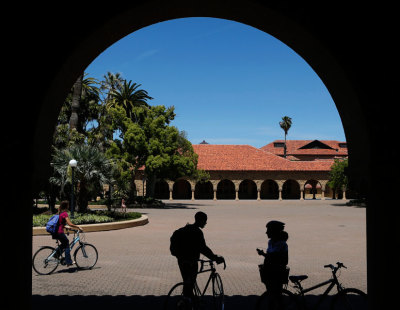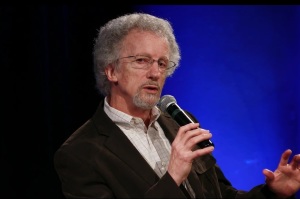A tale of 2 student protests: They're not always obnoxious

Many First Things readers are no doubt sadly aware of the disgusting treatment of federal judge Kyle Duncan at Stanford Law School last week. Duncan was visiting campus to give a lecture sponsored by the Stanford Federalist Society. But his talk was disrupted by students who heckled him for his rulings on LGBT issues.
Not only was Duncan subject to the now-traditional vile personal abuse from the pampered students who inhabit the lecture rooms of the nation’s most elite institutions, he was also treated to a lecture by the dean of diversity, equity, and inclusion (who else?) on what an evil person he is. While Stanford’s president has since apologized, it remains to be seen if the apology for allowing behavior inconsistent with the school’s policies will lead to the obvious consequence: the firing of the DEI dean for her own bizarre rant. If a senior administrator who so clearly undermines school policy is allowed to continue in office, the apology is meaningless.
Student protests and threats to speakers are not a new thing. There were student strikes at the universities of Oxford and Paris in the 13th century. Martin Luther, arriving in Leipzig to debate John Eck in 1519, surrounded himself with an armed cortège of Wittenberg students, anticipating trouble (or perhaps hoping to precipitate such) with the locals. Nineteenth-century Russia witnessed a surge in student radicalism. Dostoevsky’s The Devils provides a literary portrait of such, and the close connection between the term “intelligentsia” and revolutionary politics reflects this period. 1968 was not so much a novelty as a particularly intense example of a tradition. What Judge Duncan experienced at Stanford, while disgusting, is no innovation.
Yet protests do not always need to be obnoxious, like the one at Stanford. Some weeks ago I was myself subject to a protest while speaking at another college. The protesters, upset at my views on LGBT and Pride issues, organized opposition to my presence. But this group was different from the Stanford mob. My protesters attended my lecture, listened politely and even laughed at my jokes, asked some good questions, and then at the end left the lecture theater to hold a gathering elsewhere on campus. At no point did I feel disrespected as a human being. Far from it. I actually appreciated the protesters turning up in person to hear what I had to say. And I further appreciated being asked good questions that pressed me to sharpen my thinking on a couple of points.
The difference between my protesters and those berating Judge Duncan is this: Mine had not lost sight of the fact that they and I both share a common humanity. Nor had they lost sight of the purpose of public discourse: to persuade opponents to change their views for the better, not to terrify them into silence.
Why has this become such a rarity in our modern world? One argument is that we have coddled the younger generation and made them incapable of handling any views with which they disagree. There is truth in this, but the problem is more deeply rooted than the pedagogical decisions of my generation. It stems from a longstanding notion of selfhood that identifies personal authenticity with feelings, such that anything that disturbs those feelings is oppressive and evil.
It also connects to a common claim of the left that is now less clearly the preserve of that political wing than it once was: the demonizing of the Other. A pretentious creature of postmodernism, the Other is that threat or enemy over against which a group defines itself and justifies its actions. In earlier times, the Other was the foreigner, the homosexual, the person with a different skin color. The Other was “them” rather than “us.” Critical theories, from those dealing with gender to postcolonialism, riff on this theme as a way of debunking the claims of those in power, typically identified as white, heterosexual males. But as power has shifted, so has the nature of the Other. Postmodernism and post-structuralism are not really political in the traditional sense, but are rather subversive of all orders. Hence a new, progressive vocabulary for Othering has emerged: white supremacy, patriarchy, Christian nationalism, toxic masculinity, homophobia, transphobia, Islamophobia, etc. As with the earlier Otherings, it is easy to find individuals who do indeed represent these things; but it is also easy to reify these categories in such a way that humanity disappears and anyone with whom one happens to disagree is easily categorized and dismissed. Kyle Duncan was Othered at Stanford, such that anything he had to say was irrelevant. He was not a human being; he was merely a representative of the hated and feared Other.
I typically dislike using the pretentious jargon of the postmodern theorists, but what has been good sauce for the conservative goose for so long might now prove rather delicious and savory when applied to the progressive gander. When student protests involve an attempt to persuade the speaker to think more deeply, the protesters are treating him as a human being, not as the Other. That is how I felt my protesters treated me. Would I rather not have been protested at all? Of course. But did I feel personally abused? Not at all. However, at Stanford Judge Duncan was Othered — seen not as a human being but as an idea that needs to be erased.
No doubt there are professors in Ivy League classrooms even now declaring that Judge Duncan’s crime is that he treats those who disagree with him as the Other. The irony, of course, is that in doing so they stand guilty of precisely that of which they accuse him. But those in power have always been able to bend language to suit their own purposes. Just ask a postmodernist.
Originally published at First Things.
Carl R. Trueman is a professor of biblical and religious studies at Grove City College. He is an esteemed church historian and previously served as the William E. Simon Fellow in Religion and Public Life at Princeton University. Trueman has authored or edited more than a dozen books, including The Rise and Triumpth of the Modern Self, The Creedal Imperative, Luther on the Christian Life, and Histories and Fallacies.


























